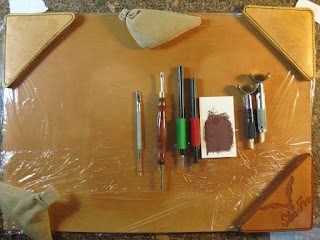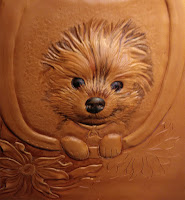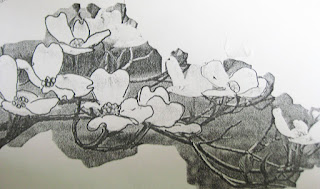Transferring a Pattern
 Some years ago, because my leather dried too quickly, I needed to figure out an option to maintain a working moisture content in the leather for longer. If leather is wet and allowed to dry too often it becomes harder, literally tougher to cut and tool. Because of this I decided to try covering the leather with plastic to retain the moisture. After trying several kinds of plastic, I settled on cling wrap, any brand. Because it is so thin and strong I can case the leather, cover it with the plastic and when it's ready for transferring a design, put the paper pattern right on top and trace away. My pattern doesn't fall apart because of the moisture and the lines remain crisp and clean. I can feel an indentation on the paper with my finger where the tracing is already done or lift and look if necessary. Tracing film works well but because of the thickness the lines transferred tend to be wide and blur when put close together. Another little time saver is to use a modeler right over the pattern to start the process of modeling some details.
Some years ago, because my leather dried too quickly, I needed to figure out an option to maintain a working moisture content in the leather for longer. If leather is wet and allowed to dry too often it becomes harder, literally tougher to cut and tool. Because of this I decided to try covering the leather with plastic to retain the moisture. After trying several kinds of plastic, I settled on cling wrap, any brand. Because it is so thin and strong I can case the leather, cover it with the plastic and when it's ready for transferring a design, put the paper pattern right on top and trace away. My pattern doesn't fall apart because of the moisture and the lines remain crisp and clean. I can feel an indentation on the paper with my finger where the tracing is already done or lift and look if necessary. Tracing film works well but because of the thickness the lines transferred tend to be wide and blur when put close together. Another little time saver is to use a modeler right over the pattern to start the process of modeling some details. Here are the tools that will be used in the next step of transferring the design. I have several tracing tools some with finer tips, others heavier in the point and dual purpose for transfer and modeling. On small works a fine point is needed to trace the smaller images and keep the lines clear enough to cut cleanly. It is not quite as tricky when the cut work is on a larger subject. Leather weights come in very handy when holding things in place
Here are the tools that will be used in the next step of transferring the design. I have several tracing tools some with finer tips, others heavier in the point and dual purpose for transfer and modeling. On small works a fine point is needed to trace the smaller images and keep the lines clear enough to cut cleanly. It is not quite as tricky when the cut work is on a larger subject. Leather weights come in very handy when holding things in placeThis deer pattern was transferred and partially modeled using Peter Main's modeling tool, a real treasure to own.
The other tools shown are a business card with jeweler's rouge to strop the cutting blade on the swivel knife. Don't sell this tool short though, it can also be used to polish your modeling spoon which makes for a drag free stroke just like it does with the swivel knife blade. Try buffing your figure carving and all smooth bevelers on this same strop, you may be pleasantly surprised with the results.
My preferred leather carving blades are 1/4" angled ceramic blades. I have very good quality steel ones but can't always sharpen them adequately. All blades must be stropped to maintain a smooth stroke. It polishes off any buildup of debris or scratches that may accumulate while carving the leather. The only drawback to ceramics is they will chip if dropped on your marble or granite.
Always buy the best tools and equipment you can afford. I've upgraded many times over the years with tools and the swivel knife is not exception. There are many on the market and I've been using the same "tried and true" two for most of my career; one is made by Pro Series Tools, Bob Beard and the other is by Chuck Smith of Chuck Smith Tools. They fit my small hands like a glove and there's no wobble or stress to my hands and fingers when I work.
Enjoy! visit silvafoxartistry.com and see my work on Linked-In, Facebook, Instagram




Comments
Post a Comment